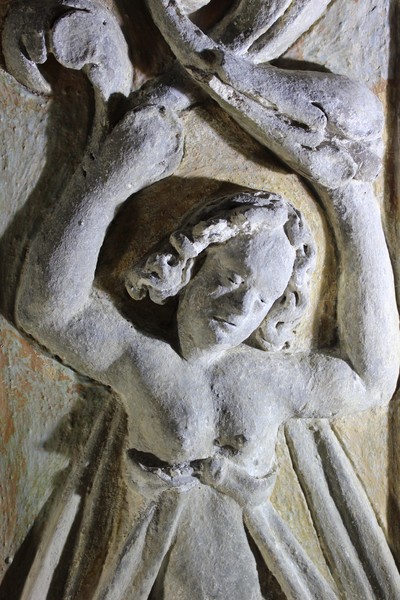Interior
The stucco decoration of the chancel vault is composed of an alternation of different figurative elements: full-length bas-relief angels, winged herms, cherubs, pendants of flowers and fruit, acanthus leaves and racemes, as well as purely decorative elements such as bands, scrolls, ribbons and cornices (Fig. 1, 2, 3, 4). All have little relief but make effective use of perspective devices for illusionistic increase of volume, seen well, for example, in the wings of the herms around the painted ovals.
The serial elements made with moulds are quite slender.
With the cover meter, the use of a few nails can be detected, fixed in the masonry at the thickest points. The reinforcement is prepared using materials such as twine, wire and iron rods, and the moulding of the volumes uses two mortars: a thick body layer and a finishing layer of about two millimetres. The body mortar has the shrinkage cracks typical of a lime and sand preparation without addition of gypsum.
The mortar of the angels at the base of the triumphal arch differs, using a coarser and darker aggregate and a substantial amount of gypsum, worked around a support structure consisting of wooden pieces of various shapes and sizes (Fig. 5, 6, 7). These technical devices enabled the artist to model the statues with strong projection, completely detached from the wall.
In places, the works preserve an extremely smooth finishing layer, the result of the careful working of a mortar composed of lime and marble dust, without addition of other aggregates. Also made with this single finishing layer are all the decorative plant parts, done freehand. There are still remnants of gilding on the angels' hair (Fig. 8, 9).
The 18th-century stuccos of the main altar were skilfully inserted into the context, particularly with respect to the chancel (Fig. 10).The fresh and rapid modelling demonstrates remarkable technical skill. The lateral parts of the broken tympanum rest on large roughly-hewn stones, inserted into the masonry of the back wall and further secured with a metal stirrup, still visible from the sides (Fig. 11). The two angels in the round, resting on the tympanum cornice, required further anchoring. Here again, Bellotti used metal brackets, around these building a very solid structure of stones with thick, coarse mortar. On this structure rests the body mortar, applied in substantial thicknesses with only a few generously loaded and rapid strokes of the trowel (Fig. ). The modelling is completed with the finishing mortar, also dextrously worked, including by direct use of the fingers.
The pyx at the apex, detached from the background cartouche with dramatic effect, is anchored using thin rods, installed almost invisibly but sufficient for the weight (Fig. 12). A horizontal rod crosses the basal axis, and a diagonal one provides reinforcement. All other wall elements (clouds, cherubs, frames) have little relief and did not need much reinforcement.
The working group may have included another other artist besides Bellotti, possibly recognisable by small stylistic differences (Fig. 13). The effect is in any case highly coherent, and demonstrates the great experience of these stuccatori, evident for example in the details worked with little thickness yet great sculptural force, such as the lively vegetal forms, and in the calculated economy of execution: in fact the areas not in view are always barely defined, without finishing (Fig. 14, 15).





























